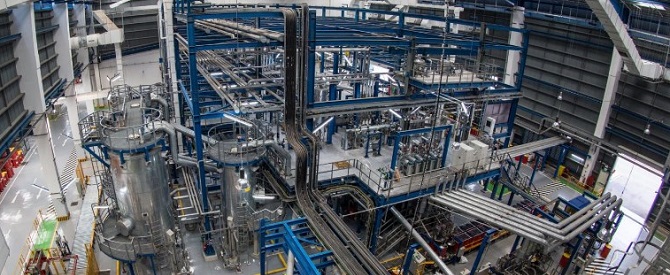Shell opened a blending plant in Singapore last week with capacity to make 390,000 tons of lubricants per year – its third-largest blending plant in the world. The globes largest lubricant supplier said it will use the facility to strengthen its supply chain and to expand in the marine market in Asia-Pacific.
The new plant is built on a 10-hectares site equivalent to about 25 football pitches in the Singapore Lube Park in Tuas, western Singapore. Its capacity is 50 percent greater than the plant in Woodlands, northern Singapore, that it replaces.
Products will be exported in bulk to more than 40 countries, mainly in the Asia-Pacific region. The plant will produce automotive, industrial and marine lubricants including Shell Helix passenger car motor oils, Shell Tellus hydraulic oils and Shell Alexia, two-stroke marine engine oil.
Unlike the manually operated older plant built in 1963, the new plant is highly-automated with automated filling and packaging lines and is mainly operated through computers from a control room, reducing human resource expenses.
This facility will further strengthen our marine lubricants businesss presence here in Singapore, the worlds second-busiest port, Shell Global Commercial Executive Vice President Huibert Vigeveno said during an opening ceremony.
To expand its marine lubricants business, Shell called on an information technology startup in London to develop big data analytics and artificial intelligence information technology systems to use in lubricant management for the shipping industry in the region.
Big data can help us forecast and take out a lot of [lubricant management] operational complexities and urgency, said Jan Toschka, executive director of Shell Marine.
Shell is conducting a trial of the new service with two global shipping companies. By using big data to analyze information like the ships routes, ports of call, engine conditions and more, the system is able to pick up numerous data points to help the ship optimize lubricant procurement and management, reducing cost.
This will affect the supply chain, and we can zoom in on a few ports to optimize lubricant purchasing for the customer, Toschka said. Shell plans to offer more commercial offerings in six to nine months. Although the company did not disclose target volumes, marine lubricants represents half of its Singapore lubricant production volume, and the company will expand capacity based on demand.
The global marine lubricants market is estimated to expand at an annual growth rate of 4.1 percent and reach U.S. $3.3 billion by 2024, said S. Iswaran, minister of trade and industry, during the ceremony. Asia pacific accounted for more than 51 percent of this market in 2015, and will likely drive future demand.
Shells new plant is located near Singapores Tuas mega-port, still under construction and expected to open in phases from 2021 when all five existing ports in the country will terminate operations and consolidate in Tuas. The automated Tuas facility will have a capacity of 65 million standard-sized (20-foot) containers, an increase from 40 million in 2016.
The Singapore Lube Park is a joint venture between Sinopec, Total and Shell, that officially opened last year. The park was developed to provide facilities like a four-berth jetty, common pipelines, infrastructure and storage facilities for the companies lubricants and grease plants. The parks base oils and finished lubricants tank farm has a capacity of 159,000 cubic meters and will be expanded to 208,000 m3 in the future.

Photo: Shel